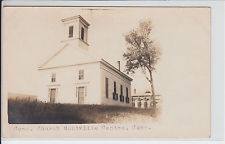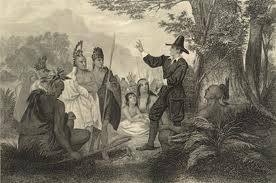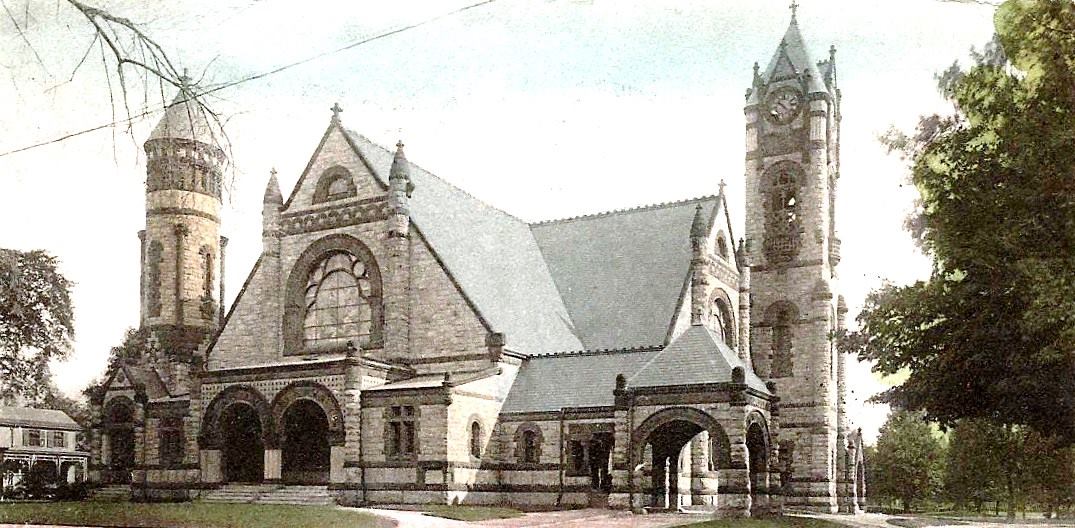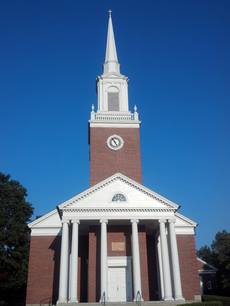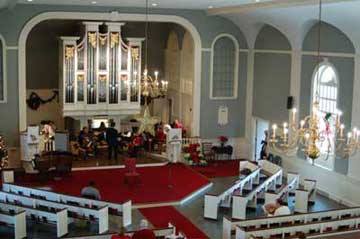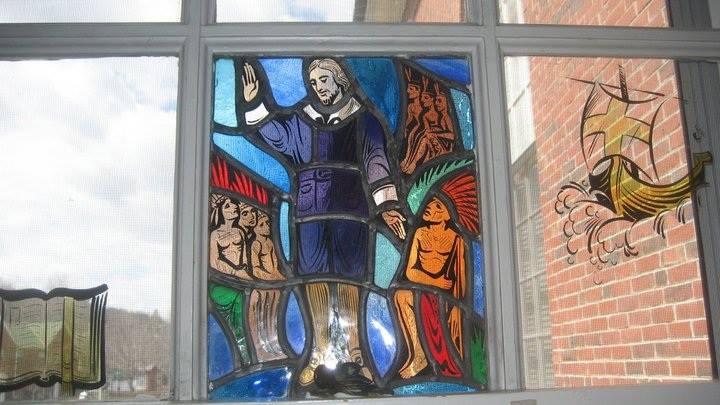Many of us know the beautiful stone church on the hillside overlooking the Mill Creek Valley and Buffalo Mound as “The Old Stone Church.” However, from its inception in 1880 (when plans and fundraising began) until 1915, the structure was known as The Eliot Congregational Church of Maple Hill, Kansas.
That may set inquisitive minds to wondering. How did the Old Stone Church get its name. The answer is quite simple. Many of the founding members of the church were members of The Eliot Church in Newton, Massachusetts before moving to Kansas.
Primary among those families were the Warren, Thayer, Cheney and Pierce Families. The Warrens, Thayers and Cheneys moved from their Eastern homes to the Mill Creek Valley in the fall of 1873, had stone homes built, and because residents in the spring of 1874.
William A. Pierce was the son of Charles Pierce, a wealthy Boston merchant and member of the Atchison, Topeka and Santa Fe Railroad board of directors. He purchased an 1,800 parcel of land on the south side of Mill Creek in 1873. There, his son became a gentleman rancher and raised fine cattle.
The Maple Hill News Items of 1876 reported the following: ” June 9 A Congregational Church was organized at Maple Hill, Thursday last, with a membership of 14. A full council was present representing the churches at Manhattan, Louisville, Wabaunsee, St. Marys, Alma, Dover, Topeka, North Topeka, and Quindaro. Rev. L. Blakesly preached the introductory sermon. Rev. R. D. Parker gave the right hand of fellowship and Rev. S. D. Storrs the charge of the church. There was a large attendance at the organization. It will be known as the Eliot Congregational Church. It is temporarily supplied by a student from Yale University. The Sunday School numbers 100.”
This new congregation made its first home in the District #39 School House which still stands (although significantly remodeled) the southern most structure on the Adams Ranch grouping of buildings as you drive north towards the Kansas River Bridge and St. Marys.
Early in January 1877 this item appeared. “January 10 The Sunday School at Maple Hill has been presented with a new library of 105 volumes and a Communion Service from eastern friends.” These items were sent by the Eliot Congregational Church in Newton.
November 19, 1879 “Maple Hill folks are endeavoring to build a new stone church on an elevated site near Mill Creek. The father of W. A. Pierce, Charles A. Pierce of Boston, has donated the land and $700 has been raised by members and friends for the purpose.”
With this little newspaper item, we have documented the original gift of 40 acres of land for the church and the cemetery. I believe that there were no additions to this original 40 acres until Warner and Emma Jeanne Adams donated an additional five acres at the north end of the present cemetery in 1978.
I’m going to stop the story here long enough to relate some information about The Eliot Church, affiliated with the United Church of Christ (formerly Congregational) in Newton, Massachusetts.
From what I have been able to learn, the congregation began in 1845 in the wealthy Boston suburb of Newton. The issue of slavery was already a very contentious one and the Newton Church was proud to become a part of the anti-slavery movement. In fact in the church history the congregation says it has never swayed from controversy when human rights were at the forefront. They were involved in the Civil Rights Movement, in their opposition to the Vietnam War, and currently in support of LGTB rights. In church history, it is stated that the membership of The Eliot Church has ranged from 50 to 1000 as a result of their stance on various issues. Membership is now around 300.
They named their congregation to honor the Puritan Pastor, Rev. John Eliot (1604-1690.) Eliot was born in England and came to American soon after the Mayflower Pilgrims in 1636. He quickly took up the cause of local Native Americans and became known as “The Apostle to the Indians.” He became so closely associated with Native People that he learned the Algonquian Language and in 1663, it was his translation of the Bible into the Algonquian language that was the first published. He continued to learn more of the local Native people’s language and begged for a second edition so that he could correct mistakes in the first. The King of England granted his request and it was published in 1685, just five years before Eliot’s death.
The congregation has suffered three disastrous fires which destroyed their first two buildings. Their present church is the third that has served the congregation. The Eastern families that were members and later moved to their new homes in the Mill Creek Valley would have just begun to attend worship in the second structure, which was enormous in comparison with the first.
August 18, 1882 “The Maple Hill Congregational Church was dedicated yesterday. Friends gathered in from far and near and the south slope of the church was filled with 74 buggies and wagons. The church was filled to overflowing. The Topeka Choir composed of Prof. Slie, Mrs. Fox, Mrs. S. P. Dunlap, Miss Fox and Rev. Blaksley, all well known to most of us, afforded excellent music. Rev. Storrs of Topeka, resplendent in flowing black tunic, provided a message of long remembered eloquence using Isaiah 2: 2-3. The other ministers participating were Rev. S. P. Dunlap and Rev. Blakeley of Topeka, Rev. Greeg of Alma and Rev. John Scott of Wabaunsee. At the close of the service, Rev. W. S. Crouch of Louisville, who has been called by the Maple Hill Church, made a lively and most interesting speech in regard to the erection of a parsonage, and through his noble efforts $365.00 was generously subscribed for that purpose. A committee of three, Mrs. A. F. Thayer, M. D. Weltner and George Moor were appointed to canvass the neighborhood to raise the remainder. Mrs. Albert Thayer and Mrs. M. J. Warren were responsible for the decks of beautiful flowers which so charmed the interior of the church.”
As a former pastor, I am able to see how it was easy to prepare a sermon for the dedication of a church from the scripture passage:
Isaiah 2:2-3New King James Version (NKJV)
2 Now it shall come to pass in the latter days
That the mountain of the Lords house
Shall be established on the top of the mountains,
And shall be exalted above the hills;
And all nations shall flow to it.
3 Many people shall come and say,
Come, and let us go up to the mountain of the Lord,
To the house of the God of Jacob;
He will teach us His ways,
And we shall walk in His paths.
For out of Zion shall go forth the law,
And the word of the Lord from Jerusalem.
July 26, 1884 “The Eliot Congregational Church held its annual meeting and it was learned that the church is now financially able to be self-supporting. Therefore, W. S. Crouch was made permanent pastor after serving for two years as temporary. Officers elected were: Trustees, J. Whittaker, C. H. Gieger, and John Tod; Clerk, Mrs. E. P. Whittaker; Treasurer, Mrs. Albert F. Thayer; and Deacons, C. H. Geiger and M. D. Weltner.”
With this announcement, financial support from The Eliot Church and the Congregational Mission Society ceased. The new stone Eliot Church on the beautiful hillside in Kansas, was able to stand on its own.
Today, the beautiful walnut pulpit and two chancel chairs donated by The Eliot Church in Newton, Massachusetts for use at the stone church are still in use by the Maple Hill Community Congregational Church in the town of Maple Hill, Kansas.
Photo 1 The original Eliot Church in Newton, Massachusetts.
Photo 2 – A drawing, “The Apostle to the Indians,” features a likeness of Rev.
John Eliot.
Photo 3. This is a photo postcard of the second structure that housed the Eliot
Church of Newton, Massachusetts. It was much grander than the first.
Photo 4. This is a photograph of the current Eliot Church, UCC, in Newton,
Massachusetts.
Photo 5. This is a photograph of a stained glass window in the present church
honoring Rev. John Eliot.
Photo 6. The interior of the present Eliot Church in Newton, Massachusetts.
